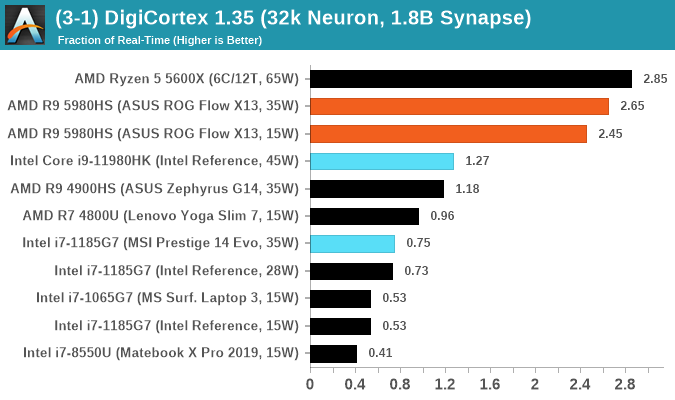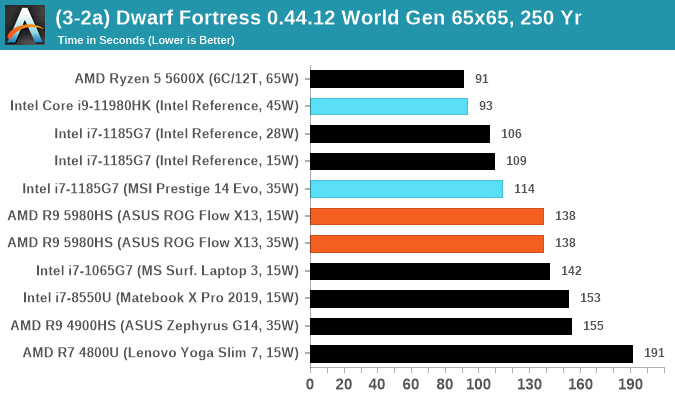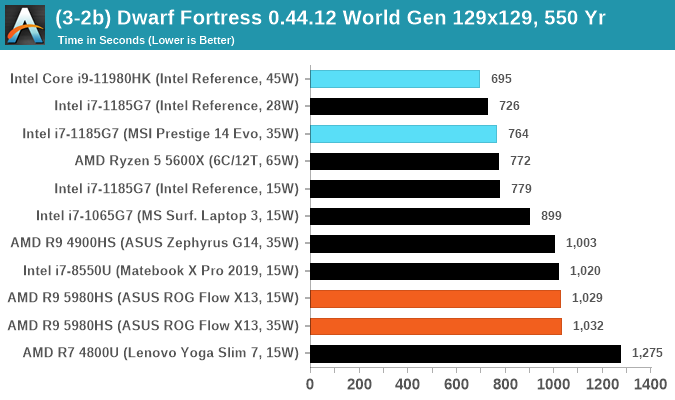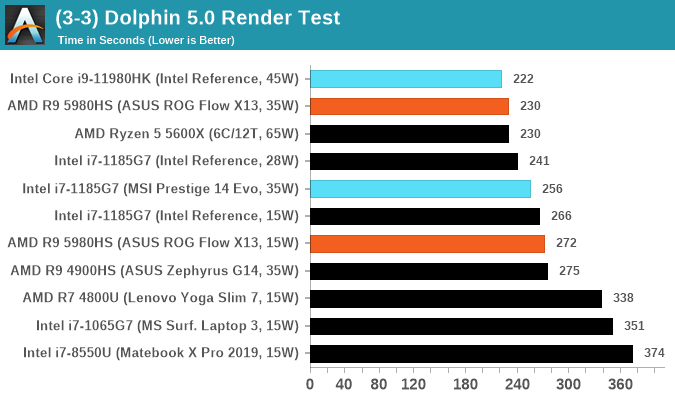Intel 11th Generation Core Tiger Lake-H Performance Review: Fast and Power Hungry
by Brett Howse & Andrei Frumusanu on May 17, 2021 9:00 AM EST- Posted in
- CPUs
- Intel
- 10nm
- Willow Cove
- SuperFin
- 11th Gen
- Tiger Lake-H
CPU Tests: Simulation
Simulation and Science have a lot of overlap in the benchmarking world, however for this distinction we’re separating into two segments mostly based on the utility of the resulting data. The benchmarks that fall under Science have a distinct use for the data they output – in our Simulation section, these act more like synthetics but at some level are still trying to simulate a given environment.
DigiCortex v1.35: link
DigiCortex is a pet project for the visualization of neuron and synapse activity in the brain. The software comes with a variety of benchmark modes, and we take the small benchmark which runs a 32k neuron/1.8B synapse simulation, similar to a small slug.
The results on the output are given as a fraction of whether the system can simulate in real-time, so anything above a value of one is suitable for real-time work. The benchmark offers a 'no firing synapse' mode, which in essence detects DRAM and bus speed, however we take the firing mode which adds CPU work with every firing.
The software originally shipped with a benchmark that recorded the first few cycles and output a result. So while fast multi-threaded processors this made the benchmark last less than a few seconds, slow dual-core processors could be running for almost an hour. There is also the issue of DigiCortex starting with a base neuron/synapse map in ‘off mode’, giving a high result in the first few cycles as none of the nodes are currently active. We found that the performance settles down into a steady state after a while (when the model is actively in use), so we asked the author to allow for a ‘warm-up’ phase and for the benchmark to be the average over a second sample time.
For our test, we give the benchmark 20000 cycles to warm up and then take the data over the next 10000 cycles seconds for the test – on a modern processor this takes 30 seconds and 150 seconds respectively. This is then repeated a minimum of 10 times, with the first three results rejected. Results are shown as a multiple of real-time calculation.

Dwarf Fortress 0.44.12: Link
Another long standing request for our benchmark suite has been Dwarf Fortress, a popular management/roguelike indie video game, first launched in 2006 and still being regularly updated today, aiming for a Steam launch sometime in the future.
Emulating the ASCII interfaces of old, this title is a rather complex beast, which can generate environments subject to millennia of rule, famous faces, peasants, and key historical figures and events. The further you get into the game, depending on the size of the world, the slower it becomes as it has to simulate more famous people, more world events, and the natural way that humanoid creatures take over an environment. Like some kind of virus.
For our test we’re using DFMark. DFMark is a benchmark built by vorsgren on the Bay12Forums that gives two different modes built on DFHack: world generation and embark. These tests can be configured, but range anywhere from 3 minutes to several hours. After analyzing the test, we ended up going for three different world generation sizes:
- Small, a 65x65 world with 250 years, 10 civilizations and 4 megabeasts
- Medium, a 127x127 world with 550 years, 10 civilizations and 4 megabeasts
- Large, a 257x257 world with 550 years, 40 civilizations and 10 megabeasts
DFMark outputs the time to run any given test, so this is what we use for the output. We loop the small test for as many times possible in 10 minutes, the medium test for as many times in 30 minutes, and the large test for as many times in an hour.


Dolphin v5.0 Emulation: Link
Many emulators are often bound by single thread CPU performance, and general reports tended to suggest that Haswell provided a significant boost to emulator performance. This benchmark runs a Wii program that ray traces a complex 3D scene inside the Dolphin Wii emulator. Performance on this benchmark is a good proxy of the speed of Dolphin CPU emulation, which is an intensive single core task using most aspects of a CPU. Results are given in seconds, where the Wii itself scores 1051 seconds.













229 Comments
View All Comments
Bagheera - Tuesday, May 18, 2021 - link
Intel isn't gonna have enough EUV in time to ramp 7nm by 2023. they are in serious trouble and floating on borrowed time, most analysts just aren't aware.https://semiwiki.com/forum/index.php?threads/will-...
Intel's 10nm is indeed competitive with TSMC 7nm in terms of density, but AMD will be moving to 5nm with Zen 4 next year, what can Intel's response be? They can increase outsourcing to TSMC but that means less utilization of their own fabs which is bad. They absolutely won't be able to get 7nm ready in time to compete with AMD on TSMC 5nm. It will be back to the status quo of Intel lagging behind AMD by one full node, and likely foregoing power efficiency for performance parity.
Bagheera - Tuesday, May 18, 2021 - link
no actual semiconductor professional expected Intel 10nm to surpass TSMC 7nm in any tangible way. the only people who expected otherwise are uniformed enthusiasts (usually gamers, who the to be partial to Intel)The gap will only widen from here. Intel really shot itself in the foot with bad EUV planning.
https://semiwiki.com/semiconductor-services/ic-kno...
watzupken - Tuesday, May 18, 2021 - link
I feel this review concludes that Intel have effectively lost their competitive edge when their fab started to lag behind. In fact, its also conclusive that the SuperFin is really nothing super at all even when compared to TSMC's 7nm. Its just 10nm on steroids just like what they have been doing to their 14nm. From an architect standpoint, Willow Cove is decent, but the bulk of the performance is due to pushing for very high clock speed at the expense of very high power consumption. If this was released on a desktop, it will be a hit. But on mobile, I don't think one can easily find a laptop that have the cooling capability to tame the heat output and also maintain a decent battery life. Especially this processor will likely be paired with a high end GPU. To me, this is a worrying trend for Intel because they will likely have to stick around with 10nm for another couple of years at least. If their new CPU architect is unable to provide decent IPC gains without bursting the power limit, they will surely be in trouble, especially when AMD's 5nm chips may appear in the market first.mode_13h - Tuesday, May 18, 2021 - link
> If this was released on a desktop, it will be a hit.Yes.
> I don't think one can easily find a laptop that have the cooling capability
> to tame the heat output and also maintain a decent battery life.
At 35 W, it would probably make a fine laptop. Unfortunately, competitive pressure is pushing Intel to juice their CPUs more than they really should.
sandeep_r_89 - Tuesday, May 18, 2021 - link
Can you please please stop using the word BIOS for modern devices? Pretty much all devices have been on UEFI only for several years now.Silver5urfer - Tuesday, May 18, 2021 - link
Ah the M1 fastest CPU ever, doesn't make it to SMT SPEC scores for some reason, like always. Don't worry we will see the Apple CPU which would be X version of the chip iteration when it finally catches up to the SMT of these SMT until then M1 is the best CPU ever.TGL machines will throttle to peak with the thin and light garbage heatsinks. That's a given, people should stop buying these parts. Laptop batteries will be destroyed eventually and none of them will have the Dell Desktop Power plan only Workstations have that feature (Lenovo and Dell), Alienware used to have, not sure about now their A51M R1 and R2 also they had their GFX modules smoke, anyways the battery won't be available for the end user to service and the expensive machine will die and BGA with soldered HW to further limit everything, add the overheating NVMe SSDs due to poor ventilation, happens in Alienware machines too which are targeted as maximum performance.
Spunjji - Thursday, May 20, 2021 - link
🤪🤡😤🤬🤥💩mode_13h - Friday, May 21, 2021 - link
Oof. Looks like *someone* is giving Emojipedia a workout!: )
Spunjji - Tuesday, May 18, 2021 - link
This ended up how I was expecting - superior single-core performance where there's thermal headroom, dropping down to broadly competitive multi-performance at the rated TDP, and with a faintly ludicrous maximum power draw under all-core boost.I'm glad it's competitive. That's needed. What I'm a little less glad about is that we're almost certainly in for another round of CPU performance varying *wildly* between different designs, which has been true to some extent for a while, but getting steadily worse ever since Ice Lake showed up.
Given most OEMs' approach to cooling, I'd wager that the average device shipping with Cezanne will provide better CPU performance than the average device with Tiger 45 simply because of Cezanne's greater efficiency.
tekit - Tuesday, May 18, 2021 - link
Heard they enabled undervolting again for tiger lake-h, can anyone confirm? I wonder how much undervolting potential there is and if that could balance the equation against AMD.